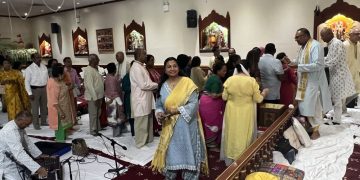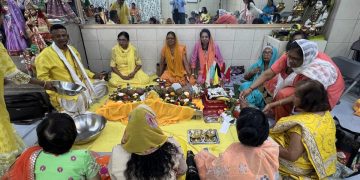It is end of year and Caribbean people in North America and Europe reminisce about the enjoyment of the year-end season as they remember it and that continues to be practiced in the region. The diaspora even transplants the practices in their new homeland such as home remodeling, decorations, baking, entertaining guests, charity, among other practices.
Living in the Caribbean, a Christianized society with strong European influence, one can’t escape being caught in festivities relating to Christmas and year-end holiday season even if one is from another faith. Although a Christian holiday, Christmas and the season take on a kind of secular atmosphere in a multi-ethnic, multi-religious society like Guyana, Trinidad, and Suriname and other places with multi-religious practice. Everyone, regardless of faith, looked forward for the season as it was a time for new clothing, special entertainment, and special meals that just before Christmas and continues a day after the New year.
Almost everyone celebrates the spirit of the holiday of sharing and caring for others especially of those less fortunate and gifting to children. They go out of their way to create joy for family members. Those not of Christian faith didn’t (don’t) partake in the church aspects of Christmas like going to mass or church, but they engage (d) in gifting and preparing elaborate seasonal meals for the family and exchanging gifts.
Some of the secular activities associated with Christmas are going shopping for new items, including clothing and decoration for the home, gift-giving, feasting, exchanging cards, charity, listening to music, watching movies, parties, being spectator of masquerade bands, going to the horse races, cooking special meals, baking, visiting friends and relatives for meals, etc. The festivities last over a week from Christmas Eve to New Year’s Day.
The year end season offers the opportunity for renewal within the home and in the yard – the equivalent of a Fall or Spring-cleaning in N.Y to get rid of fallen leaves and spruce up the surrounding and mowing the lawn and planting flowers as is done in America as the weather warm up. Season curtains are put up. And new cushions may be in place along with new spreads on the beds and new pillows to welcome the new season. New furniture may also replace older ones. Caribbean people still hold on to that practice in North America and Europe of re-modeling their home for the holidays.
Preparation for the holiday usually started weeks before X-mas even among non-Christians and the poorest sections of society. For Hindus and Muslims, the holiday season is a continuation of their festivals of Eid and Diwali which generally fall around the end of the year.
The imported Christmas tree is up for those who could afford it probably sent by relatives in North America. A tropical tree on the front yard may be lit up. Even the poorest have lights strung up. The homes are festooned with trimmings, balloons and other decorations and some brilliantly illuminated in an unofficial competition of the best lit home. The wealthy go on a splurge. Shopping districts of the towns and cities are also well decorated and music blaring to attract customers.
No Caribbean Christmas is without special music. As in North America, Christmas carols or songs are very popular – the same ones heard in North America although there are local ones (calypso, reggae, chatney, parang) and Bollywood songs (favorite of Indo-Caribbeans) as well. Businesses advertised their Christmas goods and services early and as such radio and television stations started holiday programming a whole month before the season. And the season music as well as masquerade and parang bands are evident. Christians attend church service as Christmas gets closer. Carols also performed in church in regular worship services. Church members also perform as carol singers in public places on fundraising drives.
The season is associated with baking – bread, cake, pastries and cooking a variety of dishes – and making local drinks like ginger beer, sorrel, mauby, etc., and in organizing the traditional menu for the season. There was a lot of excitement in baking; children join in the preparation.
The season is also one of giving gifts — to relatives, friends, business associates, neighbors, children, and the needy. Children were told that their gifts would be brought by Father Christmas and that they should hang socks. Gifts were opened in the morning with squeals of delight from the kids and they spend the season playing with them. Gift to adults or families could take the form of food or hampers or cake. People baked and exchange cake. Christmas and New Year Eve was a time to visit the towns or shopping district for a late outing for snacks.
Christmas is a time for family get-together. The animal was killed or meat purchased the day before or on Christmas Day or Old Year’s or New Year’s Day. Families prepare most elaborate seasonal dishes. Relatives, friends, neighbors, and co-workers were invited for a hearty meal. For dessert, cakes (black, sponge, fruit, etc.) and other goodies are served and washed down with traditional homemade drinks as well as imported cydrax, peardrax, mauby, sherry or Correia’s wine, soft drinks, and hard liquor. Apples, grapes, walnuts, dates, and candies are also served.
The season was a time for new movies and horse races and many people would go to the cinemas to view hit movies from Bollywood or Hollywood or to watch the races.
In the olden days, phone was not affordable or even available and TV was not easily accessible and even unavailable in some countries. On Christmas and New Year’s Day, they huddled around radio stations for recorded holiday messages from loved ones in Europe and North America. People were very excited to hear their name on the air. Caribbean people also tend to receive seasonal greeting cards and or money from loved ones or neighbors from abroad.
‘Yesteryear’s’ was a simple celebration in the Caribbean that lacked all of the modernities and entertainment of today. But it was fantastic with memories to treasure!








































































